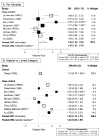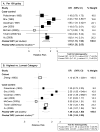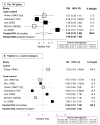Consumption of animal foods and endometrial cancer risk: a systematic literature review and meta-analysis
- PMID: 17638104
- PMCID: PMC2592095
- DOI: 10.1007/s10552-007-9038-0
Consumption of animal foods and endometrial cancer risk: a systematic literature review and meta-analysis
Abstract
This article summarizes and quantifies the current evidence relating dietary intake of animal products and endometrial cancer. Literature searches were conducted to identify peer-reviewed manuscripts published up to December 2006. Twenty-two manuscripts from three cohort studies and 16 case-control studies were identified. One of these cohort studies evaluated only fried meat and another only milk consumption; they were not included in our meta-analyses. The third cohort study identified did not present exposure levels and could not be included in dose-response meta-analysis. This cohort study did not show an association with meat or red meat consumption. Random-effects dose-response summary estimates for case-control studies evaluating these foods were 1.26 (95% CI: 1.03-1.54) per 100 g/day of total meat, 1.51 (95% CI: 1.19-1.93) per 100 g/day of red meat, 1.03 (95% CI: 0.32-3.28) per 100 g/day of poultry, 1.04 (95% CI: 0.55-1.98) per 100 g/day of fish, and 0.97 (95% CI: 0.93-1.01) per serving of dairy. Our meta-analysis, based on case-control data, suggests that meat consumption, particularly red meat, increases endometrial cancer risk. The current literature does not support an association with dairy products, while the evidence is inconsistent for poultry, fish, and eggs. More studies, particularly prospective studies, are needed.
Figures






Similar articles
-
Role of Dairy Foods, Fish, White Meat, and Eggs in the Prevention of Colorectal Cancer: A Systematic Review of Observational Studies in 2018-2022.Nutrients. 2022 Aug 21;14(16):3430. doi: 10.3390/nu14163430. Nutrients. 2022. PMID: 36014940 Free PMC article.
-
Signs and symptoms to determine if a patient presenting in primary care or hospital outpatient settings has COVID-19.Cochrane Database Syst Rev. 2022 May 20;5(5):CD013665. doi: 10.1002/14651858.CD013665.pub3. Cochrane Database Syst Rev. 2022. PMID: 35593186 Free PMC article.
-
Home treatment for mental health problems: a systematic review.Health Technol Assess. 2001;5(15):1-139. doi: 10.3310/hta5150. Health Technol Assess. 2001. PMID: 11532236
-
Effects of a gluten-reduced or gluten-free diet for the primary prevention of cardiovascular disease.Cochrane Database Syst Rev. 2022 Feb 24;2(2):CD013556. doi: 10.1002/14651858.CD013556.pub2. Cochrane Database Syst Rev. 2022. PMID: 35199850 Free PMC article.
-
A rapid and systematic review of the clinical effectiveness and cost-effectiveness of topotecan for ovarian cancer.Health Technol Assess. 2001;5(28):1-110. doi: 10.3310/hta5280. Health Technol Assess. 2001. PMID: 11701100
Cited by
-
Fish consumption in multiple health outcomes: an umbrella review of meta-analyses of observational and clinical studies.Ann Transl Med. 2023 Feb 15;11(3):152. doi: 10.21037/atm-22-6515. Ann Transl Med. 2023. PMID: 36845999 Free PMC article.
-
Diabetes Risk Reduction Diet and Endometrial Cancer Risk.Nutrients. 2021 Jul 30;13(8):2630. doi: 10.3390/nu13082630. Nutrients. 2021. PMID: 34444790 Free PMC article.
-
Dose-response meta-analysis of poultry intake and colorectal cancer incidence and mortality.Eur J Nutr. 2015 Mar;54(2):243-50. doi: 10.1007/s00394-014-0705-0. Epub 2014 May 1. Eur J Nutr. 2015. PMID: 24788671
-
A prospective investigation of fish, meat and cooking-related carcinogens with endometrial cancer incidence.Br J Cancer. 2013 Aug 6;109(3):756-60. doi: 10.1038/bjc.2013.252. Epub 2013 May 21. Br J Cancer. 2013. PMID: 23695021 Free PMC article.
-
Incidence and Trend of Type I and II Endometrial Cancer in Women from Two Population-Based European Cancer Registries (1998-2012).Int J Environ Res Public Health. 2022 Mar 23;19(7):3789. doi: 10.3390/ijerph19073789. Int J Environ Res Public Health. 2022. PMID: 35409473 Free PMC article.
References
-
-
Cancer Facts and Figures: American Cancer Society; 2006.
-
-
- Persson I, Adami H-O. Endometrial cancer. In: Adami H-O, Hunter D, Trichopoulos D, editors. Textbook of Cancer Epidemiology. New York, NY: Oxford University Press; 2002.
-
- IARC Handbooks of Cancer Prevention. Weight Control and Physical Activity. Vol. 6. Lyon: International Agency for Research on Cancer, World Health Organization; 2002.
-
- World Cancer Research Fund, American Institute for Cancer Research. Food, Nutrition and the Prevention of Cancer: A Global Perspective. Washington, DC: American Cancer Institute for Cancer Research; 1997. - PubMed
-
- Larsson SC, Wolk A. Meat consumption and risk of colorectal cancer: a meta-analysis of prospective studies. Int J Cancer. 2006;119:2657–64. - PubMed
Publication types
MeSH terms
Grants and funding
LinkOut - more resources
Full Text Sources

